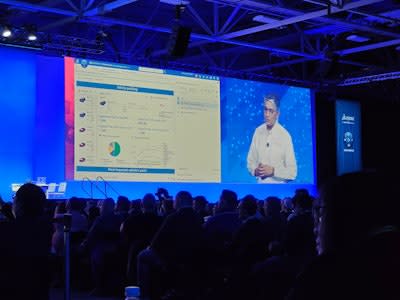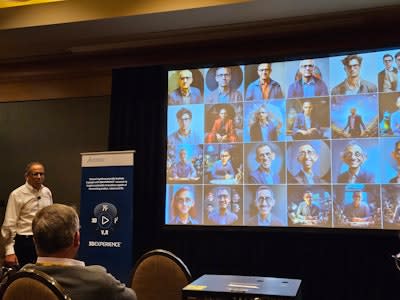Debunking the AI Myth in Manufacturing
Editor's Note: Download the audio version below.
Artificial intelligence has become a buzzword in manufacturing. At Dassault Systèmes' 3DEXPERIENCE World event in Dallas, Texas, keynote speaker and Johnson Energy Storage CTO Lonnie Johnson cited Softbank CEO Masayoshi Son, who predicted that AI would achieve an IQ of 10,000 in about 30 years—the average human IQ ranges between 85 and 115.
Some believe that AI will continue to evolve until it becomes an unstoppable force in manufacturing, rendering humans worthless.
That is the myth. However, experts in AI paint a more relaxing picture. For instance, Jillian Friot, senior manager of Dassault's 3DEXPERIENCE Lab & Accelerator, described AI as "augmented insights" over artificial intelligence.
Most Read on IEN:
Podcast: Army Scraps Billion-Dollar Program; United Grounds New Planes; Russian Component Conspiracy
The reality is that AI will continue to evolve, but not to the point of humanity's successor. Shrikant Savant, data analysis and science director at Solidworks, called the technology more of a tool that complements human expertise.
"There's always hype in terms of 'AI will replace humans’ or ‘AI will replace designers,'" Savant said. "I think that is not going to happen. I definitely think that the nature of the job that we do will change for sure, but there will always be a place for humans.
"People also tend to think that just because there is a lot of data, that you can just somehow do magic with it,” he continued “AI is really not magic. There's a lot of nitty-gritty work that goes behind the scenes. And to do that, you require humans. AI is a new way of solving problems, but it doesn't solve itself. Humans have to fine-tune it."

SolidWorks CEO Manish Kumar discusses AI during Dassault Systèmes' 3DEXPERIENCE World in Dallas, Texas.Nolan Beilstein
AI is not new. At SolidWorks, a brand within Dassault, Savant leads the development of AI and machine learning-enhanced design tools. Six years ago, SolidWorks introduced the AI Denoiser, a feature that anticipates and eliminates "noise" in an image, leading to a faster rendering time. The company also offers the Design Assistant Mate Helper, which duplicates revolute mates to multiple locations that have similar surrounding characteristics.
AI can guide the tedious and iterative design steps that take place before the physical manufacturing phase. Even after someone creates a complex design ready for manufacturing, flaws and points of failure can arise, resulting in the product returning to the design phase.
But if AI knew about related failures based on data from past experiences, it could provide feedback to the designer during the design process, saving time and money.
"Where AI can help is look at these kinds of downstream effects and have that knowledge available, so that when the user is making these design changes or making these designs, this collective wisdom that has been gathered over the years can assist the user to not make these design flaws or not make these design mistakes," Savant said.
But AI-based solutions are only as smart as the data a user provides. Users cannot simply request an AI-based solution and expect it to appear out of thin air. Manufacturers cannot present a component to AI, say, "Design me a part like this," and walk away.
"If you're feeding garbage to the AI engine, it's going to give you garbage output," Savant said. "You have to say, 'Design me a part like this that I'm going to use in [a specific] application, which is used in [a specific] industry that has its own requirements of tolerancing and material use and temperature exposure and things like that. So all of that knowledge, capturing that knowledge and providing that upfront so that the AI engine has the right data to generate the right output and generate the right tolerance, I think that becomes critical."
Determining the cause of an incorrect AI-based output can also be challenging. The data could be inaccurate, the model could be wrong, or the problem could be unforeseeable. Also, as data and complexity increase, so do required computation power and expenses.
For this reason, Savant said manufacturers will need a system to verify the results of an input and take corrective action.

Dassault Systèmes VP of Strategy & Business Development Suchit Jain discusses ChatGPT at 3DEXPERIENCE World in Dallas, Texas.Nolan Beilstein
Savant could not predict which manufacturers could most benefit from AI as the technology is still in its infancy, and use cases cover a broad range in the industry. He said the key to a manufacturer's success will be the ability to effectively define the problem they want AI to solve.
Furthermore, drawing parallels to the introduction of CNC machines, Savant does not believe that AI's advancement will lead to the replacement of factory workers. He does, however, encourage workers to familiarize themselves with the technology.
"You have to develop the skill set that is needed," Savant said. "You can do that only if you understand the technology. That doesn't necessarily mean that they have to start writing programs because that's not what everybody can do or is interested in doing. It's understanding the technology and predicting the trends of the future and seeing how they can fit themselves into those trends."
Savant reiterated that AI is not magic and characterized it as a powerful tool that can assist with problem-solving. A calculator can solve math faster than a human, but calculators did not replace humans.
"I think that people should not go into this saying, 'There is this smart thing that can just understand what I need to do and can just do it for me,'" Savant said. "There are many stages in any workflow, some of which are enhanced by AI, but there is still a huge amount of human intervention that is required in putting these pieces together. No solution is 100% AI from the beginning to the end."
